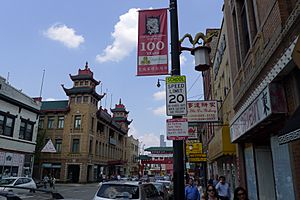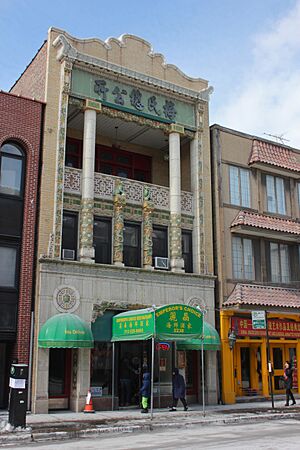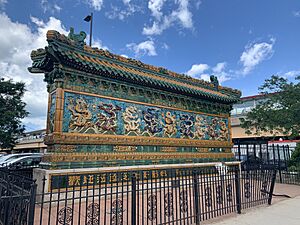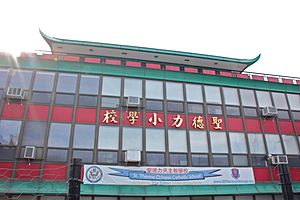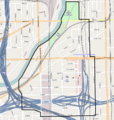Chinatown, Chicago facts for kids
Quick facts for kids
Chinatown, Chicago
|
|
|---|---|
|
Neighborhood
|
|
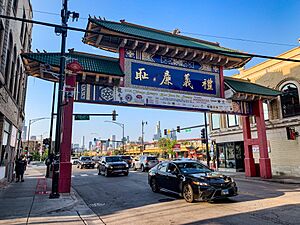
The Chinatown Gate over Wentworth Avenue
|
|
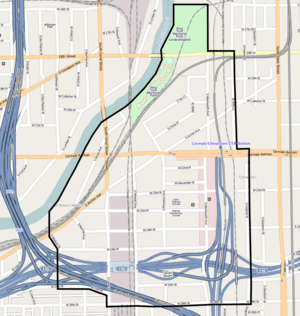
Map of Chinatown
|
|
| Country | United States |
| City | Chicago |
| Community areas | Armour Square |
| First settled | 1912 |
| Population | |
| • Estimate
(2010)
|
16,325 |
| ZIP code |
60616
|
Chinatown is a lively neighborhood on the South Side of Chicago. It's located along S. Wentworth Avenue, between Cermak Road and W. 26th Street. This area is home to many Chinese-Americans, making it one of the largest communities of its kind in the United States. Chinatown started around 1912. Before that, Chinese settlers lived closer to the Loop area in the 1800s.
Sometimes, people confuse Chicago's Chinatown with another area called "New Chinatown" on the city's North Side. That area is mostly home to people from Southeast Asia.
Contents
History of Chicago's Chinatown
How Chinatown Started in Chicago
The first Chinese people arrived in Chicago after 1869. They were looking for a safer place to live. Many faced unfair treatment and violence on the West Coast. Also, many lost their jobs after the First transcontinental railroad was finished, as they had done a lot of the work. This led them to move to other parts of the United States, including Chicago.
At first, Chinese people were generally welcomed in Chicago. They opened businesses and mixed with other residents. By the late 1800s, many Chinese residents settled on Clark Street. Here, they opened stores selling Chinese goods, restaurants, and laundries. These places became important gathering spots for the community.
Powerful family groups, called clans, also grew in Chicago's early Chinese community. The Moy clan was one of the most important. They helped new immigrants and worked with city leaders. These family ties were very strong and helped people find jobs and support each other.
Old Chinatown also saw some disagreements between different groups. These conflicts were common in Chinatowns across the country during that time.
Moving South to a New Home
Over time, things changed. After 1892, new laws made it harder for Chinese immigrants. Also, the World's Columbian Exposition in Chicago in 1893 brought more attention, and sometimes more unfair treatment, to the Chinese community. Because of this, around 1912, many Chinese residents started moving south to a new area in Armour Square.
Several reasons led to this move. Rent prices were going up, and Chinese businesses often paid more than others. There was also overcrowding and some unfair treatment. A new federal building was planned for the old Chinatown area, which meant many buildings would be torn down. So, community leaders decided it was time to find a new home.
The On Leong Merchants Association led the move. In 1912, they built a large building on Cermak Road. This building had stores, apartments, and the association's offices. It even had Chinese-style decorations like dragons. This new area near Wentworth Avenue and Cermak Road became known as "New Chinatown."
Even in the new location, the Chinese community faced challenges from existing residents. But they worked together to build their new neighborhood. Soon, over a third of Chicago's Chinese population lived in this new Chinatown.
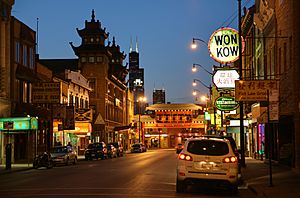
In the 1920s, community leaders worked to secure land for the growing Chinatown. They decided to build a special Chinese-style building to show the community's strong presence. The On Leong Merchants Association Building opened in 1928. It was a beautiful building with pagoda towers. It served as a community center, school, and meeting hall. People often called it Chinatown's "city hall."
Businesses like large grocery stores and restaurants became very important to Chinatown's economy. These stores sold imported goods and helped connect Chicago's Chinatown with other Chinese communities around the world. Restaurants were popular places for both Chinese residents and visitors. Many important buildings were built during this time, including the Won Kow Building and the Moy Association Building.
Chinatown After World War II
After World War II, Chicago's Chinatown began to change. More Chinese immigrants and educated people came to Chicago. Many of them chose to live in the suburbs instead of Chinatown. Also, as Chinese immigration became more accepted after 1965, younger Chinese Americans started to play a bigger role in the community.
To help connect Chinese residents across the city, the Chinatown Gateway was built in 1975. It became a symbol of unity. In the late 1980s, business leaders developed Chinatown Square, a shopping area with restaurants and shops. They also built new homes nearby. One of the best additions was Ping Tom Memorial Park, which opened in 1999. This park along the Chicago River has a beautiful Chinese-style pavilion.
Commerce and Community
| Chinatown, Chicago | |||||||||||||||||||||||||||
|---|---|---|---|---|---|---|---|---|---|---|---|---|---|---|---|---|---|---|---|---|---|---|---|---|---|---|---|
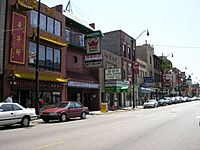
Wentworth Avenue looking south.
|
|||||||||||||||||||||||||||
| Traditional Chinese | 芝加哥華埠 | ||||||||||||||||||||||||||
| Simplified Chinese | 芝加哥华埠 | ||||||||||||||||||||||||||
|
|||||||||||||||||||||||||||
Chicago's Chinatown is a busy place! You can find many banks, delicious Chinese restaurants, gift shops, and grocery stores. There are also stores selling Chinese medicine. It's a central spot for Chinese people living in the Chicago metropolitan area and a business hub for the entire Midwest. Tourists and locals love to visit Chinatown for its unique culture and food.
Population in Chinatown
In 1990, about 10,000 Chinese people lived in Chinatown. By 2013, about 8,000 people lived there, and 90% of them were ethnic Chinese. Many residents were older adults. In 2010, the total population in Chinatown was about 16,325 people.
Unlike some other Chinatowns that have changed a lot, Chicago's Chinatown has continued to grow. More and more people identifying as Asian have moved into the surrounding areas.
Famous Spots and Fun Things to See
- Chinatown Mural: This colorful mural tells the story of Chinese immigrants in the United States.
- Chinatown Square: A shopping area opened in 1993. It's decorated with cool sculptures of animals from the Chinese zodiac.
- Wentworth Avenue: The main street, full of shops, restaurants, and famous spots like the Chinatown Gate.
- Pui Tak Center: This building used to be the On Leong Merchants Association Building. It was named a Chicago Landmark in 1993.
- Chinese American Museum of Chicago: This museum shares the history of Chinese people in the American Midwest. It reopened in 2010 after a fire, thanks to community support.
- Ping Tom Memorial Park: Opened in 1999, this park has beautiful Chinese gardens along the Chicago River.
- Chinatown Gate: This impressive gate spans Wentworth Avenue at Cermak Road. It was designed by Peter Fung.
- Moy Association Building: Built in 1928, this is one of the most impressive buildings in Chinatown.
Schools and Learning
Schools for Kids in Chinatown
Students living in Chinatown go to schools run by the Chicago Public Schools. These include John C. Haines School and Phillips Academy High School.
John C. Haines School, built in 1994, serves students from Chinatown. In 2001, most students were Asian, and others were Black. The school has worked to help students from different backgrounds get to know each other.
The Roman Catholic Archdiocese of Chicago also runs the St. Therese Chinese Catholic School. This private Catholic school for grades K-8 has one of its campuses in Chinatown. It opened in 1941.
The Pui Tak Christian School is another private school for pre-kindergarten to 8th grade.
Public Libraries
The Chicago Public Library has a branch right in Chinatown! It's located at 2100 South Wentworth Avenue.
Culture and Traditions
Chinatown has strong family ties, which helps keep the community close.
Chicago Chinatown celebrates important events. They have the Double Ten Parade to celebrate the founding of the Republic of China, with lion dances and flags. They also celebrate the National Day of the People's Republic of China.
Getting Around Chinatown
Chinatown is easy to get to! The Dan Ryan Expressway and the Stevenson Expressway are nearby. You can find street parking with meters or use one of the pay parking lots on Wentworth Avenue.
Public transportation is also available:
- The Chicago Transit Authority (CTA) has an elevated train station. The Red Line, which runs 24/7, stops at the Cermak–Chinatown station.
- Several CTA bus routes serve the area, including the #24 on Wentworth Avenue, the #44 on Canal Street, the #21 on Cermak Road, and the #62 on Archer Avenue.
- You can also find a taxicab stand on Wentworth Avenue.
- In the summer, a water taxi service runs along the Chicago River from Michigan Avenue to Ping Tom Memorial Park in Chinatown.
Fun Annual Events
- Chinatown 5K: A fun race through the neighborhood.
- Lunar New Year Parade: Celebrate the new year with a colorful parade.
- Dragon Boat Races: Exciting boat races on the Chicago River.
- Chinatown Summer Fair: A big fair with food, music, and activities.
- Chicago Chinatown Chamber of Commerce Tours: Guided tours to learn more about Chinatown.
Images for kids


